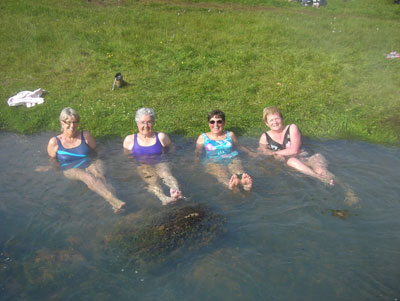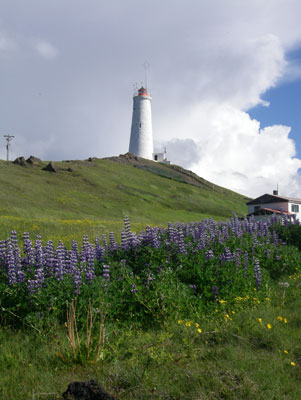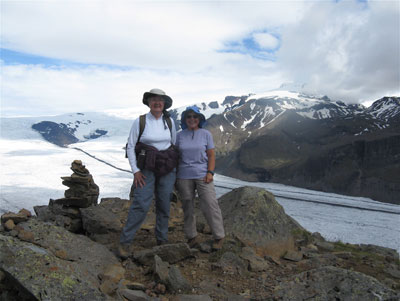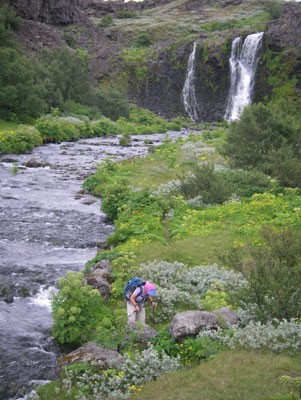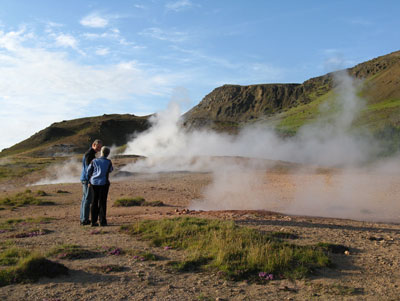Reflections on southern Iceland
by Leslie Romer, Olympia, WA
I made my first visit to Iceland on Elderhostel’s “Walking and Hiking in Iceland” tour in August ’07. Having previously taken tours on six continents, I was surprised to find that at the end of that 10-day stay I was reluctant to leave. Why was I, a longtime resident of the gorgeous Pacific Northwest, so drawn to this small country with so few trees?
I spent that fall and winter reading about Iceland and planning my return. In late June ’08 I went back for two weeks with my friend Doris to take a closer look at southern Iceland and to see whether the attraction was serious or just a passing fancy.
Getting there
We flew Icelandair (800/223-5500) from the US. Nearly all flights from the US arrive around 6:30 a.m. Airfares vary seasonally, with fares for flights in the 2-month peak summer season being the highest. We each paid $1,575 from Seattle, in part because we waited until April to book. However, in checking rates for next summer, I've noticed that prices have dropped considerably ($700 round trip from Boston).
At Keflavík International Airport, we picked up our VW Polo ($1,150 for two weeks, with a 1,400-kilometer limit) from the Icelandic National Car Rental agency (phone +354 568 6915, ) and headed west on the Reykjanes Peninsula. It should be noted that anyone wanting to drive the roads in Iceland’s interior identified as “F roads” will need a 4x4.
First day’s discoveries
We hoped to see puffins at the sea cliffs near the Reykjanes Lighthouse. On our way there we spotted the Bridge Between the Continents Park, a small park along Road 425 with a display explaining that the North American tectonic plate meets the Eurasian plate in Iceland. This appears on the landscape as a rift that is growing wider by a few centimeters each year.
At the sea cliffs the puffins were not cooperative, but 4-foot tall lupines were in full blue bloom near the red-and-white lighthouse, providing great photo opportunities. Doris told me that we identified 230 plants in bloom during our stay — a good reason to arrive early in the summer season.
Our next stop was a small but fascinating geothermal park at Krísuvík featuring boiling mudpots and colorful sulfur-stained slopes. A short boardwalk leads visitors to several effective viewpoints.
I had visited the famous Blue Lagoon (phone +354 420 8800) previously, but Doris was curious, so we drove past, as it is located on the same peninsula, west of Reykjavík. This large, well-advertised bathing spa has turned a geothermal power plant’s cooling pond into a colorful tourist attraction. We didn’t enter but paused to view the bright-blue mineral-laden water that has escaped to roadside pools.
Reykjavík
Driving into Reykjavík, we easily found Hótel Cabin (phone +354 511 6030), our lodging for the beginning and ending of our 2-week stay in Iceland. We had reserved a mid-priced room (Ikr18,550, or $230), called “deluxe,” and were delighted to find that this gained us a seventh-floor view of Reykjavík Bay.
After checking in and buying a phone card, we found our way to the Elliðaárdalur Valley, an undeveloped park within the city, for an afternoon walk. We wandered the informal trails, enjoying the wildflowers, small waterfalls and occasional views of the city above the green valley.
We found dinner at a casual restaurant in downtown Reykjavík, wandered the streets as the city’s famous nightlife began to build, and headed to bed early on our first day in country.
As at most Icelandic hotels and inns, Hotel Cabin’s room rate includes a generous breakfast buffet. And, like most of the larger hotels, they don’t appreciate guests packing lunch at the buffet. With a few exceptions, our lunches consisted of packaged sandwiches that we bought at gas stations ($3-$5 each) and fresh fruit purchased at groceries plus energy bars and trail mixes that we had brought with us.
Much of the food sold in Iceland is imported, so there is no restriction on the foods that travelers bring with them. Despite this, we did enjoy many excellent meals comprised primarily of food grown in Iceland.
Leaving Reykjavík, we headed east on Highway 1, the paved highway that has encircled the island nation since the 1970s. The weather was clear and the landscape a combination of vivid green vegetation and dramatic gray rocks. Doris, a resident of New Mexico, kept saying “Wow! This is beautiful!”
Traffic was light once we were a few miles outside of the city. (More than half of the country’s 320,000 people live in and around Reykjavík.)
Foreign visitors now exceed the Icelandic population each year. With tourism becoming a major industry, English is valued as the most popular second language. Almost everyone in business or in the hospitality industry speaks English well — at least in the southern region of Iceland that we visited on this trip.
Birds and waterfalls
For our trip, we had a well-constructed itinerary provided by an Icelandic travel agent, Bragi Ragnarsson (phone 822 1015), whom I had met in his role as an excellent driver-guide for my previous year’s tour. It, along with our hotel reservations, provided the framework for our exploration of this region of the country.
On our second day we visited two waterfalls within a few minutes of Highway 1: Urriðáfoss and Seljalandsfoss. The first of these falls is a turbulent tumble of water running over large boulders, with the highest volume of any waterfall in Iceland.
Seljalandsfoss is a tall, beautiful flow that falls from the cliff above. It is also an established tourist attraction, with a large car park, restrooms and a steady stream of tourist buses.
If you are wearing sturdy walking shoes, you may want to follow the increasingly wet (and briefly steep) trail that goes behind the waterfall. The view through the waterfall curtain is unmatched!
Dyrhólaey, a nearby headland with a grand view of the coastline, is a major bird-watching site. Walking along the cliff edge, we saw many birds soaring between the cliffs and the sea below, while others settled on ledges up and down the cliffs. We gained our best views of the charming and colorful puffins there and saw great skuas and kittiwakes as well. We also had our first views of birds we would see again and again: ringed plovers, whimbrels and redshanks.
Country inns
Most of the lodgings we stayed in outside of Reykjavík were farm inns. In all cases, we stayed in buildings located adjacent to working farms and constructed specifically to house visitors.
On our first three nights outside the city, we stayed at Hótel Geirland (phone +354 487 4677), just down the road from the village of Kirkjubæjarklaustur and the Stjórnarfoss waterfall. Room rates were a little below $200 for a double room with private bath, including breakfast.
The value of Iceland’s currency, the krona, had been fluctuating over the year prior to my visit, ranging from 60 kronur to the dollar in August ’07 to 54 kronur in November and 80 in June ’08. Anticipating that variations will continue, I have provided rounded prices in dollars based on my 2008 visit. (Editor’s note — at time of publication, the exchange was 129 kronur to $1.)
The Geirland inn served the best dinners that we experienced anywhere on the island, featuring Klausterbleikja (local “river trout”) and delicious lamb, very fresh salads and several desserts, including skyr, Iceland’s version of yogurt.
The staff at the Geirland were very helpful in answering our questions, and the inn provided free computer access in one corner of its dining room.
Later in our trip we spent two nights at Hotel Freyja, well up the Þjorsá River Valley. The inn nestles on a hillside, with all the guest rooms looking over a grand vista. As at the other farm inns, meals were served in a central dining room in the main building.
The owners and their four children provided all staffing for the hotel, from handling reservations and the front desk to the kitchen and maintenance. Fresh-baked goods were a feature of meals at the Freyja, with irresistible breads served at every meal.
We also spent three nights at Eldhestar (phone +354 480 4800), a horse farm. It is within sight of Highway 1, but we were pleased to realize that we could not hear traffic noise anywhere at the inn.
Because they feature a stable of Icelandic horses and offer trail rides, Eldhestar employs a large summer staff. During our visit, they all were from Sweden and spoke excellent English.
Eldhestar had been near the epicenter of earthquake damage in the spring of 2008, but they had almost everything working well by the time we visited in early July. We were disappointed that they were not able to get their hot tubs repaired for the summer season, and some of the lighting in the halls seemed temperamental, but everything else appeared to be working well.
The one small town hotel we stayed in was Hótel Hvolsvöllur (fax 487 8058), located in the town of the same name. It has small hot tubs on its roof that we welcomed after a day of hiking.
Arriving there after staying in a couple of farm inns, we were unimpressed with its features until we encountered its seafood buffet. It included a wide array of seafood prepared in many delicious styles. Then we learned that this was just the appetizer course!
Exploring saga lands
The Icelandic sagas are generally recognized as precursors of modern European literature. The stories were written down in the 13th century, but they record both everyday life and the heroic deeds of Icelanders at home and in Northern Europe that took place several centuries earlier.
Njál’s Saga is considered one of the best, if not the ultimate saga. The Saga Centre in Hvolsvöllur focuses on Njál’s Saga and proved well worth visiting ($9). It offered a half-hour film which whetted our appetites for the rest of the story plus a walk-through display of the entire story, including an explanation of the historical and cultural settings.
This visit provided an excellent background for our exploration of saga sites in the Hvolsvöllur area. The two heroic characters of the saga, Gunnar and Njál, both lived on their farms in this area, and many of the place names in the tale still appear on local maps.
The center provided a map which had clear directions to various sites in the tales. Several of them had large, multilanguage informational signs.
We visited the site of Njál’s farm last. We learned that an archaeological dig at the site had confirmed that a farmhouse had burned there at the time of that saga. The details provided by the archaeologists brought the old tales to life for me. I easily imagined the feuding Viking farmers on the scene a thousand years before.
This visit to the scenes from Njál’s Saga prepared us for a later visit to Keldur Farm ($4 admission), a saga-era farm on the other side of Hvolsvöllur. It is the only Icelandic farm building known to have been continuously occupied from the year 1000 to the 20th century. Different sections of the farm buildings were expanded and restored at different times, but the site’s guide provided a clear picture of how farm life evolved through the centuries.
From our base at Hotel Freyja in the Þjórsá River Valley, we later visited two versions of a large, saga-era farmhouse. A 1939 archaeological dig at Stöng (a bumpy 5-kilometer drive off Highway 35) uncovered the foundation of a farmhouse that had been occupied until the 1104 eruption of Mt. Hekla. To protect the foundation, a roof had been added but not much more.
A reconstruction of the Stöng farmhouse (admission $6) was more recently built near the paved Highway 35. It is fully furnished and has English-speaking guides, who provided us with a good picture of rural life in Iceland a thousand years ago.
Hiking the landscape
My friend and I had traveled to Iceland to hike, so we took every opportunity to stretch our legs in the interesting landscape.
When based at Hotel Geirland, we spent one day going to Skaftafell National Park, about 75 kilometers to the east. This national park was recently expanded to include all of the largest glacier in Europe. Admission is free, and the visitors’ center, modeled after smaller American national park centers, included a regularly run film.
There we took the opportunity to do one of the longer hikes of our trip, following a trail that passed the Svartifoss (Black Falls) and provided several viewpoints overlooking the Skaftafellsjökull (jökull = glacier) and then crossing the ridge to look down on the Morsárjökull before returning to the visitors’ center.
Closer to Geirland, we took several short hikes in one day, starting with a walk to the Systrastapi, an interesting butte beside the Klauster River. Stopping closer to the village, we hiked up a steep but short trail beside the Systrafoss (another waterfall) that led to a lake, Systravatn.
We had decided to have a restaurant lunch that day and treated ourselves to an enjoyable meal at the Systra Kaffi in Kirkjubæjarklaustur for about $10 each. In the afternoon we drove out to a beautiful river gorge, Fjaðrárgljúfur.
The river had etched a deep canyon between tall stone walls, leaving many strange and beautiful shapes in the walls and towers that remain. We followed a short, steep trail down into the gorge and walked along the stony beach a short distance until it ended at a cliff.
We returned to the rim of the canyon and walked its 2-mile length, peering down into the deeply cut gorge and admiring the beautiful rock walls and green water at the bottom.
In the Þjórsá River Valley we hiked through pastureland along a 3-mile-long fence line to great views of Háifoss, at 400 feet Iceland’s second-tallest waterfall. It is otherwise accessible by a long, winding, bumpy dirt road.
We also hiked twice to the beautiful hidden valley of Gjáin. Several waterfalls flow into this miniature Eden full of wildflowers, exotic rock formations, tumbling streams and crystalline pools of water.
We first walked to it on a narrow road through a dark volcanic landscape, which provided a sharp contrast to the verdant scene that opened at the valley’s rim. The next day we followed the short path from Stöng and entered the valley on the other side of the Fossá River.
Near the end of our stay, we had the opportunity to hike with my guide/friend Bragi and his wife, Jónína, on trails near Reykjavík. Doris and I had hoped to bathe in a natural hot spring during our stay in Iceland, and hiking the geothermal trails near Mt. Hengill provided that opportunity.
We spent most of the day hiking a landscape dotted with plumes of steam, shaggy sheep bounding away as we approached. A few kilometers from the end of the trail at the town of Hveragerði, our route paralleled a stream that was bubbling and steaming. We followed it downhill until we reached a wide spot, where the water was cooled to a more comfortable temperature. We modestly slipped into bathing suits and entered the stream, women from one bank and gentleman from the other.
Another morning, Bragi led us up Mt. Esja, the tall ridge that overlooks Reykjavík and the surrounding coastline. This is a popular hike for city dwellers, being just a half hour’s drive from downtown. With a gain of 2,500 feet in altitude in just 2½ miles, it qualifies as a steep hike, with a well-protected peak register on top for successful hikers to sign in. We made it!
Excursions
We planned on three excursions during our stay that would allow us to experience areas we could not reach with our automobile. The first was a guided sea kayak tour (phone +354 896 5716) from the small town of Stokkseyri. For $70 each we were provided with a sit-on-top kayak, paddle, life vest, waterproof coveralls and tall rubber boots.
Offshore was an array of stony ridges — the tops of a lava field now submerged by the edge of the ocean. We paddled through channels between the ridges, well protected from the ocean currents beyond. Our teenaged guide explained the landscape and pointed out and identified birds and seals as they appeared around us.
After a charming 2-hour excursion, we realized why a visit to the town swimming pool was included in the price of the kayak tour. There were not only a shower and a changing room but hot tubs and a warm outdoor pool to aid our restoration.
The weather interfered with our taking an excursion that Doris and I had both enthusiastically anticipated. When I learned that there were flights to the Westmann Islands (Vestmannaeyjar) available for only $75, I eagerly added that day trip to our itinerary. Reservations for the short flight from Bakki can be made by phone a day or two ahead (phone +354 481 3255). The flight schedule can be found online.
Wind on the day of our original reservation and then wind followed by fog the next day caused us to save this side trip for another year.
Our last excursion taught us several lessons. We chose to overcome the limitations of our rental car by taking a Reykjavík Excursions bus tour (phone +354 580 5400) to the Lakagígar volcanic area, located well into the rough interior of southern Iceland. For $73 we had a 9-hour tour, including two short stops and two longer halts for hikes. The bus starts at Skaftafell, also accepting passengers at Kirkjubæjarklaustur.
The first surprise was that the driver spoke very little English. I remembered that the website description had said “this tour is CD-guided,” so I didn’t worry. But when no recorded voice appeared, I asked about it. The driver gave me an apologetic explanation: it was the first run of their summer season, and the CD player wasn’t working.
Without a guide or preparation, I did not consider this a day well spent.
Reykjavík ramblings
How you spend your time in the city will depend on your individual interests. There are numerous museums, parks and shopping opportunities. The modernistic architecture of the landmark Hallgrímskirkja is usually worth a visit, but the church was undergoing a noisy renovation.
I enjoyed returning to the room-sized, 3-dimensional map of Iceland in the Municipal Building beside the downtown lake, Tjörnin. It helped put my travels into perspective.
I have not yet found the nearby National Legislative Building (AlÞing or Althing) open to visitors but plan to persist in my attempts.
We had lunch one day at The Pearl but not at the reputedly high-priced revolving restaurant there. Instead, we ate in the overpriced cafeteria on a lower level ($18 for soup and salad) and enjoyed the views of the city and beyond from the outer deck. Another day we wandered into an elegant downtown bistro, B5 (Bankastraeti 5) and had a significantly better meal. I enjoyed a particularly fine duck and pear salad for $21.
I discovered that, yes, my attraction to Iceland continues. As I write, I am beginning to plan my 2009 trip.
Iceland is a friendly, welcoming place to visit and explore. The daytime temperatures in the summer months range from the 50s to the 70s, making it ideal for touring and hiking. There are many more fjords, waterfalls and glaciers yet to see in the other regions of the country and many more interesting people to meet along the way. I know I will be glad to meet them all.


